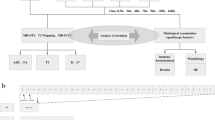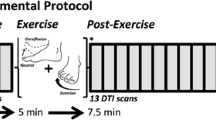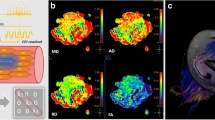Abstract
Objectives
Diffusion tensor magnetic resonance imaging (DTI) and T2 mapping enable the detection of exercise-induced changes in the skeletal muscle microenvironment. This study prospectively quantified DTI metrics and T2 relaxation times of thigh muscles in competitive triathletes at rest and following a triathlon race in comparison with sedentary controls.
Methods
Twenty-two triathletes (males N = 16, females N = 6) and twenty-three controls (males N = 16, females N = 7) underwent magnetic resonance imaging (MRI) on a 3 T system at baseline (time point 1; 72 h at rest). Twelve triathletes (males N = 8, females N = 4) underwent a second scan (time point 2; 3 h of completing a triathlon race). The tensor eigenvalues (λ1, λ2, λ3), mean diffusivity (MD), fractional anisotropy (FA), and T2 times were compared between controls and triathletes at time point 1 and triathletes at time points 1 and 2 using independent and paired t tests.
Results
In comparison with the controls at time point 1, the T2 times of rectus femoris (RF, p < 0.02), adductor magnus (AM, p = 0.02), biceps femoris (BF, p < 0.001), semitendinosus (ST, p = 0.005), and semimembranosus (SM, p = 0.003) muscles were significantly increased in triathletes. At time point 2 in triathletes, the average tensor metrics (MD, λ3/ λ1) of BF, ST, and SM muscles increased (p < 0.05) and FA values in ST and SM muscles decreased (p < 0.03). T2 times were not significantly changed between both time points in triathletes.
Conclusion
Our results indicate that this multiparametric MRI protocol allows detection and quantification of changes in the skeletal muscle microenvironment caused by endurance training and acute strenuous exercise.
Key Points
• Endurance training results in changes to the skeletal microstructure, which can be quantified using MRI-based diffusion tensor imaging.
• The combined application of MRI diffusion tensor imaging and T2 mapping allows the differentiation of microstructural changes caused by active exercise or endurance training.
• Environmental adaptations of the skeletal muscle caused by physical training are influenced by gender.





Similar content being viewed by others
Abbreviations
- ADC:
-
Apparent diffusion coefficient
- AM:
-
Adductor magnus
- BF:
-
Biceps femoris
- CI:
-
Confidence interval
- CK:
-
Creatine kinase
- DTI:
-
Diffusion tensor imaging
- FA:
-
Fractional anisotropy
- FOV:
-
Field of view
- MD:
-
Mean diffusivity
- MFF:
-
Muscle fat fraction
- MRI:
-
Magnetic resonance imaging
- RF:
-
Rectus femoris
- ROI:
-
Region of interest
- SM:
-
Semimembranosus
- SNR:
-
Signal-to-noise ratio
- ST:
-
Semitendinosus
References
Damon BM, Ding Z, Anderson AW, Freyer AS, Gore JC (2002) Validation of diffusion tensor MRI-based muscle fiber tracking. Magn Reson Med 48:97–104
Basser PJ, Pierpaoli C (1996) Microstructural and physiological features of tissues elucidated by quantitative-diffusion-tensor MRI. J Magn Reson B 111:209–219
Galban CJ, Maderwald S, Stock F, Ladd ME (2007) Age-related changes in skeletal muscle as detected by diffusion tensor magnetic resonance imaging. J Gerontol A Biol Sci Med Sci 62:453–458
Galban CJ, Maderwald S, Uffmann K, Ladd ME (2005) A diffusion tensor imaging analysis of gender differences in water diffusivity within human skeletal muscle. NMR Biomed 18:489–498
Froeling M, Oudeman J, Strijkers GJ et al (2015) Muscle changes detected with diffusion-tensor imaging after long-distance running. Radiology 274:548–562
Giraudo C, Motyka S, Weber M et al (2018) Normalized STEAM-based diffusion tensor imaging provides a robust assessment of muscle tears in football players: preliminary results of a new approach to evaluate muscle injuries. Eur Radiol 28:2882–2889
Okamoto Y, Mori S, Kujiraoka Y, Nasu K, Hirano Y, Minami M (2012) Diffusion property differences of the lower leg musculature between athletes and non-athletes using 1.5T MRI. MAGMA 25:277–284
Tahir E, Starekova J, Muellerleile K et al (2018) Myocardial fibrosis in competitive triathletes detected by contrast-enhanced CMR correlates with exercise-induced hypertension and competition history. JACC Cardiovasc Imaging 11:1260–1270
Shoepe TC, Stelzer JE, Garner DP, Widrick JJ (2003) Functional adaptability of muscle fibers to long-term resistance exercise. Med Sci Sports Exerc 35:944–951
Aagaard P, Magnusson PS, Larsson B, Kjaer M, Krustrup P (2007) Mechanical muscle function, morphology, and fiber type in lifelong trained elderly. Med Sci Sports Exerc 39:1989–1996
Ma J (2008) Dixon techniques for water and fat imaging. J Magn Reson Imaging 28:543–558
Wang Z, Yamamura J, Keller S (2019) Signal-to-noise ratio assessment of muscle diffusion tensor imaging using single image set and validation by the difference image method. Br J Radiol 92:20190133
Froeling M, Nederveen AJ, Nicolay K, Strijkers GJ (2013) DTI of human skeletal muscle: the effects of diffusion encoding parameters, signal-to-noise ratio and T2 on tensor indices and fiber tracts. NMR Biomed 26:1339–1352
Keller S, Chhabra A, Ahmed S et al (2018) Improvement of reliability of diffusion tensor metrics in thigh skeletal muscles. Eur J Radiol 102:55–60
Shellock FG, Fukunaga T, Mink JH, Edgerton VR (1991) Acute effects of exercise on MR imaging of skeletal muscle: concentric vs eccentric actions. AJR Am J Roentgenol 156:765–768
Jenner G, Foley JM, Cooper TG, Potchen EJ, Meyer RA (1994) Changes in magnetic resonance images of muscle depend on exercise intensity and duration, not work. J Appl Physiol (1985) 76:2119–2124
Ploutz LL, Tesch PA, Biro RL, Dudley GA (1994) Effect of resistance training on muscle use during exercise. J Appl Physiol (1985) 76:1675–1681
Patten C, Meyer RA, Fleckenstein JL (2003) T2 mapping of muscle. Semin Musculoskelet Radiol 7:297–305
Fleckenstein JL, Haller RG, Lewis SF et al (1991) Absence of exercise-induced MRI enhancement of skeletal muscle in McArdle’s disease. J Appl Physiol (1985) 71:961–969
Houmard JA, Smith R, Jendrasiak GL (1995) Relationship between MRI relaxation time and muscle fiber composition. J Appl Physiol (1985) 78:807–809
Fleckenstein JL, Canby RC, Parkey RW, Peshock RM (1988) Acute effects of exercise on MR imaging of skeletal muscle in normal volunteers. AJR Am J Roentgenol 151:231–237
Meyer RA, Prior BM (2000) Functional magnetic resonance imaging of muscle. Exerc Sport Sci Rev 28:89–92
Ogawa S, Menon RS, Kim SG, Ugurbil K (1998) On the characteristics of functional magnetic resonance imaging of the brain. Annu Rev Biophys Biomol Struct 27:447–474
Askling CM, Tengvar M, Saartok T, Thorstensson A (2007) Acute first-time hamstring strains during high-speed running: a longitudinal study including clinical and magnetic resonance imaging findings. Am J Sports Med 35:197–206
Orchard J, Best TM, Verrall GM (2005) Return to play following muscle strains. Clin J Sport Med 15:436–441
Kujala UM, Orava S, Jarvinen M (1997) Hamstring injuries. Current trends in treatment and prevention. Sports Med 23:397–404
Zaraiskaya T, Kumbhare D, Noseworthy MD (2006) Diffusion tensor imaging in evaluation of human skeletal muscle injury. J Magn Reson Imaging 24:402–408
Deux JF, Malzy P, Paragios N et al (2008) Assessment of calf muscle contraction by diffusion tensor imaging. Eur Radiol 18:2303–2310
Sinha U, Yao L (2002) In vivo diffusion tensor imaging of human calf muscle. J Magn Reson Imaging 15:87–95
Heemskerk AM, Strijkers GJ, Vilanova A, Drost MR, Nicolay K (2005) Determination of mouse skeletal muscle architecture using three-dimensional diffusion tensor imaging. Magn Reson Med 53:1333–1340
Karampinos DC, King KF, Sutton BP, Georgiadis JG (2009) Myofiber ellipticity as an explanation for transverse asymmetry of skeletal muscle diffusion MRI in vivo signal. Ann Biomed Eng 37:2532–2546
Hatakenaka M, Matsuo Y, Setoguchi T et al (2008) Alteration of proton diffusivity associated with passive muscle extension and contraction. J Magn Reson Imaging 27:932–937
Enns DL, Tiidus PM (2010) The influence of estrogen on skeletal muscle: sex matters. Sports Med 40:41–58
Kendall B, Eston R (2002) Exercise-induced muscle damage and the potential protective role of estrogen. Sports Med 32:103–123
Tiidus PM (2005) Can oestrogen influence skeletal muscle damage, inflammation, and repair? Br J Sports Med 39:251–253
Edouard P, Feddermann-Demont N, Alonso JM, Branco P, Junge A (2015) Sex differences in injury during top-level international athletics championships: surveillance data from 14 championships between 2007 and 2014. Br J Sports Med 49:472–477
Alonso JM, Edouard P, Fischetto G, Adams B, Depiesse F, Mountjoy M (2012) Determination of future prevention strategies in elite track and field: analysis of Daegu 2011 IAAF Championships injuries and illnesses surveillance. Br J Sports Med 46:505–514
Alonso JM, Tscholl PM, Engebretsen L, Mountjoy M, Dvorak J, Junge A (2010) Occurrence of injuries and illnesses during the 2009 IAAF World Athletics Championships. Br J Sports Med 44:1100–1105
Funding
The authors state that this work has not received any funding.
Author information
Authors and Affiliations
Corresponding author
Ethics declarations
Guarantor
The scientific guarantor of this publication is Dr. med. E. Tahir, MD.
Conflict of interest
The authors of this manuscript declare no relationships with any companies, whose products or services may be related to the subject matter of the article.
Statistics and biometry
One of the authors (Pimrapat Gebert) has significant statistical expertise.
Informed consent
Written informed consent was obtained from all subjects (patients) in this study.
Ethical approval
Institutional Review Board approval was obtained.
Methodology
• prospective
• case-control study and cross sectional study design
• performed at one institution
Additional information
Publisher’s note
Springer Nature remains neutral with regard to jurisdictional claims in published maps and institutional affiliations.
Electronic supplementary material
ESM 1
(DOCX 17 kb)
Rights and permissions
About this article
Cite this article
Keller, S., Yamamura, J., Sedlacik, J. et al. Diffusion tensor imaging combined with T2 mapping to quantify changes in the skeletal muscle associated with training and endurance exercise in competitive triathletes. Eur Radiol 30, 2830–2842 (2020). https://doi.org/10.1007/s00330-019-06576-z
Received:
Revised:
Accepted:
Published:
Issue Date:
DOI: https://doi.org/10.1007/s00330-019-06576-z




